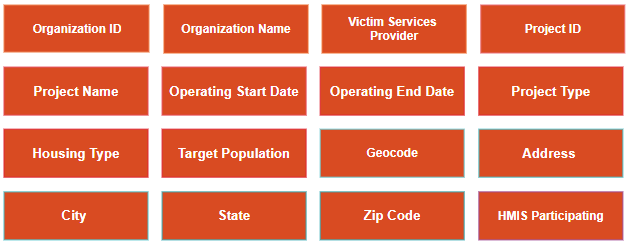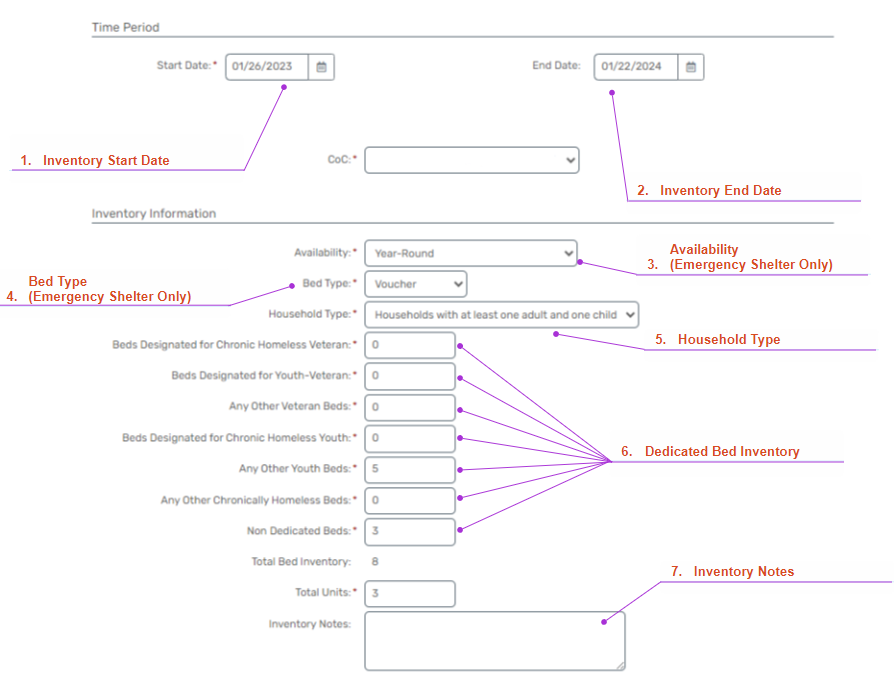Table of Contents
Overview
Every year, Continuums of Care (CoCs) conduct two crucial counts, providing stakeholders with insights into the extent of homelessness in each community and the resources available to address it. The data collected from these counts is not only submitted to HUD and Congress for national-level analysis but also serves as a measure of progress and vital tools for local CoCs in decision-making and education. These significant reports are the Point-in-Time Count (PIT) and the Housing Inventory Count (HIC). For experienced HMIS Administrators, this is familiar territory, but if you're encountering these reports for the first time, it's advisable to start with the overview to get you up to date.
PIT & HIC Overview
PIT Overview
The Point-in-Time (PIT) count is a nationwide poll of both sheltered and unsheltered individuals experiencing homelessness on a specific night in January. The Sheltered Point-in-Time count is required to be submitted annually, while the Unsheltered Point-in-Time Count is required bi-annually, but highly recommended annually. Per HUD regulations, Continuums of Care (CoCs) are required to conduct this count, encompassing individuals in emergency shelters, transitional housing, Safe Havens, and Rapid Rehousing* on that designated, Point-in-Time night.
To be brief:
What: The Point-in-Time (PIT) count is an annual HUD required poll of both sheltered and unsheltered individuals experiencing homelessness.
Who: Emergency Shelters, Transitional Housing, Safe Havens, and Rapid Rehousing*.
When: On a locally defined, specific night in January.
Who is not counted in the PIT:
❌ Households counted in locations not listed on CoCs’ Housing Inventory Count (HIC)
❌ Households residing in permanent housing (PH) programs
❌ Households temporarily staying with family or friends (i.e., “doubled-up” or “couch surfing”)
❌ Households residing in housing they rent or own, including persons enrolled in Rapid Re-Housing (RRH) projects that have a Move-In Date as of the night of the count
❌ Persons residing in institutions (e.g., jails, juvenile correction facilities, foster care, hospital beds, detox centers)
* In order to be counted in the PIT, household in RRH must not have a Move-In Date.
HIC Overview
The Housing Inventory Count (HIC) is a point-in-time snapshot of bed and unit availability of programs operating within an given Continuum of Care. The HIC provides valuable insights to the homeless assistance community regarding the capacity to house individuals who are experiencing homelessness at both local and national levels. These programs allocate beds and units with the explicit purpose of aiding individuals experiencing homelessness,, including those identified as homeless at entry for permanent housing projects as per HUD's definiton. The inventory categorizes programs into five distinct project types: Emergency Shelter, Transitional Housing, Rapid Re-housing, Safe Havens, and Permanent Supportive Housing.
To be brief:
What: The Housing Inventory Count (HIC) is a point-in-time snapshot inventory at a specific point in time, covering provider programs within a Continuum of Care.
Who: Emergency Shelter (ES), Transitional Housing (TH), Rapid Re-housing (RRH), Safe Havens (SH), and Permanent Supportive Housing (PSH) (this includes Other PH (OPH): PH – Housing with Services, and (PH – Housing Only).
When: The snapshot of inventory should be representative of the beds and units available on the locally defined Point-in-Time count above.
Which projects are not considered for the HIC:
❌ Non-residential projects (i.e. Services Only, Coordinated Entry, Street Outreach)
❌ Projects operating outside of the CoC's geographic location
Benefits of the PIT & HIC Report
Gathering accurate data on the numbers and characteristics of homeless individuals and families, alongside evaluating homeless services capacity, goes beyond mere HUD requirements. The benefits are diverse, including (but not limited to):
- Local Planning
- Program Development
- Community Goal Definition
- Progress Measurement
- Resource Allocation Optimization
- Raise Awareness
In essence, the systematic collection of accurate data not only fulfills regulatory requirements but also serves as a dynamic tool, seamlessly integrating creativity, community engagement, and progress tracking in the ongoing battle against homelessness.
For detailed information on these reports, refer to the 2024 HIC and PIT Notice. This document, provided by HUD, delineates the stipulated requirements for both reports. It's noteworthy that these reports are incentivized in the CoC Program Competition, reinforcing a commitment to ongoing data maintenance.
Are you ready for the PIT?
The unsheltered Point-in-Time (PIT) count is a substantial community effort that demands extensive coordination among service providers, community members, municipal entities, and individuals experiencing homelessness. When it comes to the PIT, preparation is key. as the saying goes, “to get there early is on time and showing up on time is late.” Although this article doesn't provide a step-by-step guide to conducting a Point-in-Time count, it does share valuable tips accumulated by CoC Administrators over time to assist you.
HMIS tips & ideas…
“Prep training materials in advance and ensure everyone knows how to complete the survey.”
“Analyze individuals with prolonged enrollments in Emergency Shelter projects; cross-verify with the respective agencies to confirm their current presence and status, distinguishing them as outliers rather than errors.”
“Follow up with agencies post-PIT by sending an email containing their PIT report, and request data confirmation and/or any necessary changes in HMIS.”
Even though a substantial portion of the count takes place outside of HMIS, it is important to ensure that households in the relevant project types are included and that all the necessary information is compiled for submitting a quality report.
Speaking of quality, the HUD Data Quality report is a good tool that can help you make sure your data looks tidy. Any work you can do now and in preparation for the big day will help you. If there's data missing, make a point to get it before or at least on the day of the count.
Run the ClientTrack's Point-in-Time Count report using the Point-in-Time date.
Our report includes both Sheltered and Unsheltered Populations.
To be in the sheltered population results: households must have an open enrollment in the participating project types on the night of the PIT Date.
To be in the unsheltered population results: households must have received a particular e on the same day as the PIT count.
Are you ready for the HIC?
According to HUD's Data Manual, an HMIS must maintain accurate Bed and Unit Inventory Information for all continuum residential projects. These records are established during the initial HMIS project setup and require annual review and updates. Finalized and accurate data should be entered by the time of the HIC.
Data elements involved in the HIC

For the most part, in ClientTrack you should be able to see all these data elements using 2 baseline forms (depending on your customizations, this number may vary): HMIS Organization Setup and Project Setup.
Once the Organization and Project setup has been verified, the next step is to make sure your inventory is correct and for that, let's review the Project Bed and Unit Inventory Form.
Anatomy of the Project Bed and Unit Inventory Form

This may seem like a lot, but here's good news for anyone working on the HIC: its accuracy is primarily reliant on setup data.
The Inventory Start Date should reflect when these records first became available under the relevant project, with the option to estimate if the precise date is unavailable. Fields 1 and 2 will help you determine whether the inventory is Current (available for the count), or Under Development (not available for the count)
Emergency Shelter Bed and Unit Availability can be setup this way:
- Year-round: beds and units are available on a year-round basis.
- Seasonal: beds available on a planned basis with specified start and end dates.
- Overflow: beds that meet demand beyond planned capacity, offered as needed throughout the year.
Bed Type only applies for Emergency Shelters and the three options are:
- Facility-based: Beds in a dedicated homeless facility.
- Voucher: Beds in hotels/motels provided through vouchers.
- Other: Beds in churches or non-dedicated facilities.
The notice defines the 3 options for Household Type like this:
- Households without children: Beds/units for adults
- Households with at least one adult and one child: Beds/units for adults and children
- Households with only children: Beds/units exclusively for children
As for the Dedicated Bed Inventory, here is where you can capture beds funded by HUD and/or other federal partners dedicated to specific subpopulations.
Feel free to check the Final 2024 HIC and PIT Data Collection Notice for a comprehensive understanding, especially regarding any unclear definitions in this section. Remember, you can always reach out to HUD through an AAQ or have a chat with your data liaison for further clarification.
Keep in mind that:
- Beds may be counted across categories (e.g., both chronically homeless and veteran).
- Report veteran, youth, and chronic homeless beds by household type.
- Include all beds associated with a dedicated unit, even if not all occupants match the subpopulation.
- Report dedicated beds even if temporarily unoccupied by matching individuals.
- Regardless of the number of beds reported, there should not be any empty cells (null values), use zeroes instead.
In ClientTrack, you can use the Inventory Notes field to chronicle inventory changes as they occur.
This method invaluable during reporting season, offering a detailed record for explanations and justifications of inventory adjustments.
HMIS tips & ideas…
“Download the previous year's HIC from HDX and use it as a baseline to track changes and add comments.”
“Verify the accuracy and currency of bed/unit inventories by having agency administrators confirm their up-to-date status.”
“I streamlined the process with quarterly bed and unit inventory submissions from agencies, creating a familiar routine for the HIC. This proactive approach proved incredibly beneficial, ensuring a more efficient experience for all involved.”
“I typically scheduled a meeting with agencies with a history of issues or discrepancies to ensure clarity.”
Helpful Links:
